Rajasthan was sitting high on my India travel bucket list for decades due to its captivating blend of history, culture, architecture and natural beauty. Visiting the “Land of Kings” to experience the royal vibes first-hand had been long overdue.
I'm thrilled to share that we finally made it happen! Jaipur and Ranthambore Tiger Reserve were chosen as the destinations for our summer break this year. The twins had over two months of school holidays and were geared up for an adventure. We had heard that summer was a good time to spot wildlife, especially tigers, at Ranthambore so that was the main reason why we decided to plan our trip in early April despite the start of the fierce summer in Rajasthan (typically beginning from March onwards).
Along with my husband, children, parents, niece and nephew, this holiday promised to be a fun-filled multigenerational family getaway 😊
For the accommodation, I was keen on staying at a heritage hotel or a haveli that would offer a glimpse into the region's rich culture and history. We found just the place - Umaid Bhawan, a charming heritage-style boutique hotel located in the serene Bani Park neighborhood. It offered the best of both worlds: a peaceful retreat that was still close to Jaipur’s vibrant city center. Run by the erstwhile royal family of Borunda, Umaid Bhawan felt like the perfect base for our Rajasthani escapade.
From the moment we arrived, we were struck by the haveli's vibrant decor and regal charm - a stunning blend of traditional Rajasthani architecture and warm hospitality.
We had booked two Royal Suites, both of which were spacious, elegantly furnished, and steeped in character. One of our rooms even had two private balconies, one offering a lovely view of the city. Waking up in a heritage haveli, surrounded by ornate arches, vintage murals, and the gentle echo of old-world charm, felt like slipping into antiquity.
I couldn't wait to do a detailed tour of the property. The ceilings, decorative moldings, wallpaper, upholstery, light fixtures, mirrors, wall art, antique furnishings, decor accents - absolutely everything was worth checking out.
A holiday that begins on the right foot even before we step out of our hotel surely sets the tone for good times ahead!
We found so many amazing photo spots within the property which we used to our advantage 😁
With its beautifully carved balconies, open terraces, lush green lawns, and inviting courtyards, the entire property exuded a timeless grandeur where echoes of the past seamlessly blended with the present.
The in-house restaurant served Rajasthani cuisine along with popular North Indian and International dishes. The wait at the restaurant was made enjoyable by live performances of traditional Rajasthani folk dance. This turned out to be an unexpected delight that added to the cultural immersion.
A highlight for our family was the large swimming pool, which offered a good degree of privacy from the rest of the hotel. Our children looked forward to their daily swim sessions, and the beautiful setting made it even more enjoyable.
We started our exploration of The Pink City with a visit to some of its architectural gems. Nestled in the heart of Jaipur’s old city, the City Palace is a stunning blend of Rajput and Mughal architecture, offering a glimpse into the opulence of royal Rajasthan.
Within its ornate courtyards lies the Textile Gallery, showcasing exquisite royal costumes and handwoven fabrics, and the Arms Museum, displaying a striking collection of intricately crafted weapons and armor.
The Diwan-i-Khas, or Hall of Private Audience, is one of the most breathtaking spaces within Jaipur’s City Palace. This grand hall was once used by the Maharajas to host private meetings with royal guests and dignitaries. Its interiors are a visual treat featuring lofty white marble columns, glittering crystal chandeliers, and richly adorned orange/pink ceilings and walls that echo the regal splendor of a bygone era. The hall also houses two enormous silver urns — officially recognized as the world’s largest silver objects — which were used by Maharaja Sawai Madho Singh II to carry holy Ganga water to England.
Don’t miss the Pritam Niwas Chowk, famous for its four beautifully adorned doorways, each representing a season: the Lotus Gate (summer), Rose Gate (winter), Peacock Gate (autumn), and Lehariya Gate (spring). These gates are not just entryways, but vibrant works of art that make the palace a photographer’s paradise.
The iconic Hawa Mahal, or “Palace of Winds,” is Jaipur’s most photographed façade - a five-storey pink sandstone honeycomb of 953 tiny windows designed for royal women to observe street life without being seen. While its beauty up close is undeniable, one of the best ways to truly admire its structural brilliance is from one of the rooftop cafés or coffee shops located opposite the street. Since I had done my research beforehand, we sat in a cafe sipping lassi and enjoying an unobstructed view of the Hawa Mahal.
A UNESCO World Heritage Site, Jantar Mantar in Jaipur is not just a collection of curious-looking structures but a marvel of science, astronomy, and architecture from the 18th century. Built by Maharaja Sawai Jai Singh II, this open-air observatory houses the world’s largest stone sundial and a series of ingenious instruments that can still accurately measure time, predict eclipses, and track celestial bodies. What makes Jantar Mantar truly special is how it blends scientific precision with artistic elegance. This is a place where astronomy meets heritage in the most fascinating way.
The Moti Dungri Ganesh Ji Temple, one of Jaipur's most revered temples is known for its divine power and spiritual energy was first on our list of places to visit on day two of our Jaipur sightseeing. I was surprised when I was encouraged by the staff there to take photos inside the temple.
Just a stone’s throw away, sitting atop a hill was the majestic Birla Mandir, a modern marble marvel dedicated to Lord Vishnu and Goddess Lakshmi. The Birla Mandir stood gracefully against the backdrop of the Aravallis. The temple was scrupulously clean and endlessly peaceful. While photography is allowed on the temple grounds and around the adjacent territories, it is not permitted inside the temple itself.
One of the most serene stops of our trip was Sisodia Rani ka Bagh, a lush, terraced garden built for a queen. With its ornate pavilions, flowing fountains, and wall frescoes depicting Radha-Krishna tales, it felt like stepping into a forgotten romantic retreat, far removed from the hustle and bustle of the city.
Since it was the beginning of summer in Rajasthan, the relative lack of crowds made the sightseeing experience enjoyable. We didn't encounter, traffic jams, wait times or throngs of people anywhere!
The Albert Hall Museum was a beautiful blend of Indo-Saracenic design and rich history. Gazing at the ancient artifacts or simply admiring the building itself, provided an educational experience while granting us some much-needed respite from the blistering afternoon heat!
Inside, the museum boasts a diverse collection of over 20,000 artifacts, including Rajasthani miniature paintings, traditional textiles, ancient sculptures, and decorative arts from various cultures.
I really liked the coin gallery which showcased coins from the Mughal era to the British occupation.
Every social media user/content creator will be enthusiastic for a vibrant photo stop at Patrika Gate, a riot of colors and intricate artwork. This is a place where every pillar tells a story, and every arch feels like walking into a painting.
No matter what time you go to Patrika Gate, I am willing to bet that you will have to contend with photo enthusiasts or fashionistas or influencers or photoshoot customers hogging the aisle to capture the gorgeous backdrop. The only reason I managed to get a picture is thanks to one of my twins who is extremely patient and is great with camera angles 😉
We spent an unforgettable evening at Chokhi Dhani, a themed village in Jaipur that is known for recreating a traditional village atmosphere. The folk music, ghoomar, mehendi, puppet shows, boating, games, camel rides and replicas of temples and historical sights brought the local culture alive in the most delightful way.
Jauhar Kund has been depicted at the Chokhi Dhani village. Jauhar was the ancient Indian practice of mass self-immolation on a pyre.
Rani Padmavati, the woman who wanted to protect the honor of the Rajputs after the siege of Chittor in 1303, did so by committing jauhar to avoid being captured by the invading army. The Rajputs’ strong sense of honor made Padmavati take the drastic step so that the victory of Alauddin Khilji, the powerful ruler of the Khilji dynasty of Delhi Sultanate, would be rendered hollow, for there would be no royal women left for him and his army to enslave and exploit.
We thoroughly enjoyed a Rajasthani fine dining experience while we were at Choki Dhani. A royal thali was served to us Rajputana style in beautiful brass utensils and cutlery as we sat comfortably in a tastefully done airconditioned banquet hall while listening to soothing live music. It was a wonderful end to the day.
The children loved the Chokhi Dhani village experience so much that they didn't want to leave!
The next day, we left bright and early for another day of exploration. First stop on our agenda was the Jal Mahal, or the "Water Palace". This is one of Jaipur's iconic landmarks, situated in the middle of Man Sagar Lake. Built in the 18th century by Maharaja Madho Singh I as a royal retreat, this building showcases a harmonious blend of Rajput and Mughal styles. The palace features five stories, with four submerged beneath the lake's surface, giving it the appearance of floating on water. Jal Mahal offers a picturesque view against the backdrop of the Aravalli hills.
Personally, Jal Mahal was a bit of a letdown. While I can see how the floating palace could be a photographer’s dream during sunrise or sunset, it desperately needs better upkeep to live up to its potential.
In contrast, I’d highly recommend visiting Panna Meena ka Kund—a stunning, thousand-year-old stepwell with intricately symmetrical steps and a quiet charm that transports you straight into the past.
Perched majestically on the rugged Aravalli hills, Amer Fort (or Amber Fort) is where Jaipur’s royal legacy truly comes alive. Wandering through its sprawling courtyards, grand gateways, and intricately decorated halls feels like stepping into a time capsule of Rajput grandeur.
The fort's pale yellow and pink sandstone façade hides a treasure trove of architectural marvels, none more awe-inspiring than the Sheesh Mahal, the legendary Mirror Palace. With thousands of tiny, hand-cut mirrors adorning its walls and ceilings, the Sheesh Mahal shimmers with even the faintest flicker of light, creating a magical, starry illusion that is nothing short of spellbinding. This is a place where history, artistry, and a touch of fairytale fantasy converge.
Jaipur’s amazing forts - Jaigarh, and Nahargarh stood like sentinels of time, each offering a different slice of history and sweeping views of the Aravallis.
In between sightseeing, we wandered through the bustling lanes of Bapu Bazaar and Johri Bazaar, spoilt for choices when it came to handcrafted souvenirs, textiles, juttis and sparkling jewellery.
My mother and I came back, grinning ear to ear, with a bagful of vibrant block printed kurtas, dresses, Bandhini printed salwar sets, Jaipur quilts, lac bangles and accessories.
Then came our much-anticipated visit to Ranthambore Tiger Reserve which had a different rhythm from Jaipur entirely. We had booked a roomy 8-seater vehicle for the entire duration of our holiday with a capable and courteous driver who was more than willing to accomodate our travel schedule. The drive from Jaipur to Ranthambore on the well-maintained national highway was smooth and scenic, with the changing landscapes offering plenty to admire along the way.
The Royal Bengal Tiger is the national animal of India chosen for its cultural significance, grace, strength, agility, and power. India is home to the largest population of wild tigers in the world, so we Indians have an inherent, deep-rooted fascination and admiration for the animal.
Ranthambore Tiger Reserve is one of India’s most celebrated wildlife destinations, located in the Sawai Madhopur district of southeastern Rajasthan. Spread across nearly 1,334 square kilometers, it was once the private hunting ground of the Jaipur royals and is now a protected sanctuary for tigers and many other species of wildlife.
What makes Ranthambore special is the dramatic landscape consisting of a wild mix of dry deciduous forest, rocky hills, ancient banyan trees, and serene lakes, all crowned by the majestic Ranthambore Fort, a UNESCO World Heritage Site that dates back to the 10th century. This is one place where visitors have a chance to spot a tiger with a 1,000-year-old fort in the background!
I had tried for weeks in advance to secure a jeep booking for the safari to make our experience more comfortable and personalized, but all my efforts were in vain. We finally had no choice but to settle on a canter safari which was arranged by the Ranthambore Tiger Machan resort that we were staying at. In hindsight, the canter safari turned out to be much better than what I had imagined and since it was able to accommodate all of us, we were able to enjoy the safari together.
I had been to Bandipur National Park and Nagarhole Tiger Reserve in Karnataka many times. I would typically see plenty of animals, but my tally of tiger sightings stubbornly stood at zero. I always felt like I was unlucky when it came to spotting the elusive apex predator. So, when we decided to visit Ranthambore, I reigned in my expectations. What gave me a flicker of hope, though, was the landscape of the region. Unlike the dense, emerald jungles of South India, Ranthambore's arid, rugged and open terrain would make potential tiger sightings easier.
We went on two safaris at Ranthambore, and much to our astonishment, we had the privilege of one, not two but FIVE tiger sightings!
On the first day, we saw tigress Riddhi in zone 3. She was taking a nap in the afternoon heat and was out of our range of vision. We waited patiently for her to wake up and caught a glimpse of her as she sauntered over to the water’s edge. This was a brief sighting, hence, there was no scope for photo opportunities.
The next day morning, we woke up early, groggy and bleary-eyed only to be treated 30-mins later to the sighting of the three sub-adult offsprings of tigress Arrowhead and another unrelated tiger in zone 2. The siblings still haven't marked their own territories and like to stay close to each other, so it was a treat to catch sight of them in the same area. There were several canters and jeeps that had stopped to admire the powerful predators. Turns out that even VIPs aren't immune to the allure of the tiger which is probably why we saw Rahul Gandhi in the jeep right behind our canter.
The tigress Arrowhead, who apparently got injured by a crocodile bite while crossing the lake and has been operated on twice since then, is out of action and prefers to stay out of sight for the most part. We were informed by our guide that she is being provided live bait to ensure her survival.
It was not just the children in the canter but us adults as well who were thrilled to bits to behold the majestic tiger in its natural habitat. I totally get why tiger spotting is such an exhilarating experience. I honestly could have watched them for hours. Our canter had a couple of wildlife photographers who had cameras that looked more like nuclear warheads! It is quite possible that it was due to their enthusiasm that we could get to spend so much time watching the big cats.
While on the subject of tigers, within a month of our visit to Ranthambore, we were dismayed to find out that one of the sub-adult tigers that we had seen, Kankati, had been responsible for the death of two people within the reserve premises. She is currently housed in an enclosure within the reserve with her future uncertain. Such incidents are a reminder that when humans encroach upon tiger habitats, the chances for such deadly encounters increase and disrupt the delicate balance of coexistence.
Coming back to the safari, we also saw lemurs, peafowl, painted storks, many other species of birds, wild hog, crocodiles, spotted deer, sambar deer and black tail mongoose.
Before leaving Ranthambore, we did a spot of shopping at Dastkar, an NGO has offered a unique collection of eco-conscious crafts made by rural artisans from around the area.
We got back to Jaipur still on a high from Ranthambore. I was able to catch up with one of my close friends from dental school and meet his family. My husband and I also made a quick pit-stop at Rawat Mistan Bhandar for some kachori and ghevar which were so delicious that we somehow made space in our already crammed bags to bring some back to Bengaluru as well.
Even with two senior citizens, four kids under the age of 12 and less-than-ideal weather, our trip went without a hitch and was eventful while being relaxing at the same time. I wouldn't change a thing!
Rajasthan swept us off our feet with its vibrant tapestry of culture, color, and history. Through it all, the warmth of Rajasthani hospitality shone through. The locals were always smiling and helpful with a cheery "koi dikkat nahi" (aka no problem) as a response to any perceived conundrum. And as a hard-core foodie, the explosion of flavors in every meal, from dal baati churma to gatte ki sabzi, ghewar, lassi and kulfi made this journey truly memorable. Rajasthan isn't just a destination, it is an experience stitched together with royalty, vibrancy, and soul.
Rajasthan, this is only the beginning! With enchanting cities like Udaipur, Jodhpur, and Jaisalmer still waiting to be explored, I know that we will be back for more of your magic 💫
Have you been to Rajasthan? What did you like best about your visit? Leave a comment to let me know.
Cheers,
Megha
















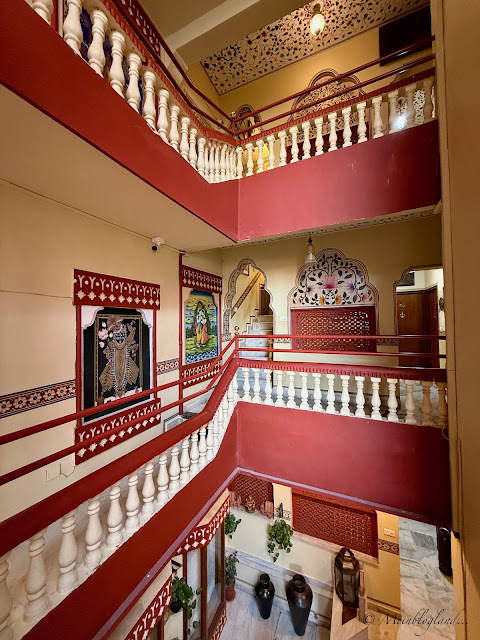














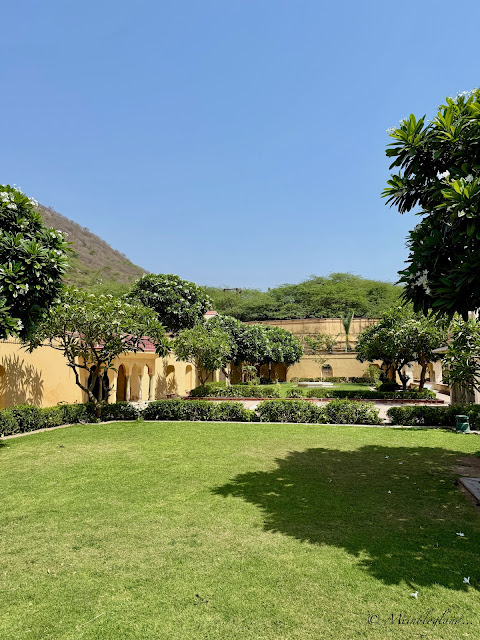










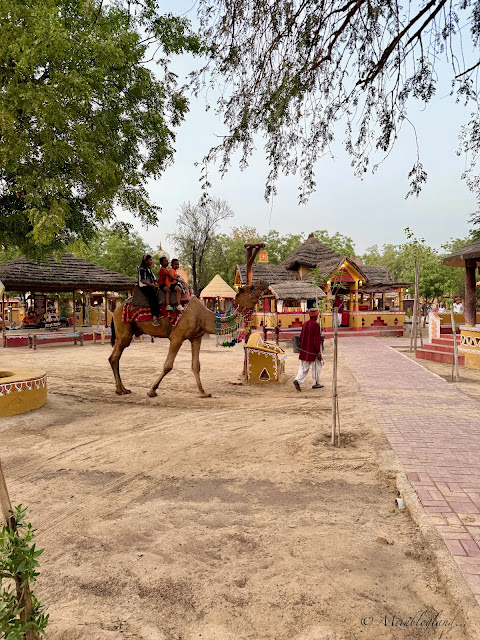










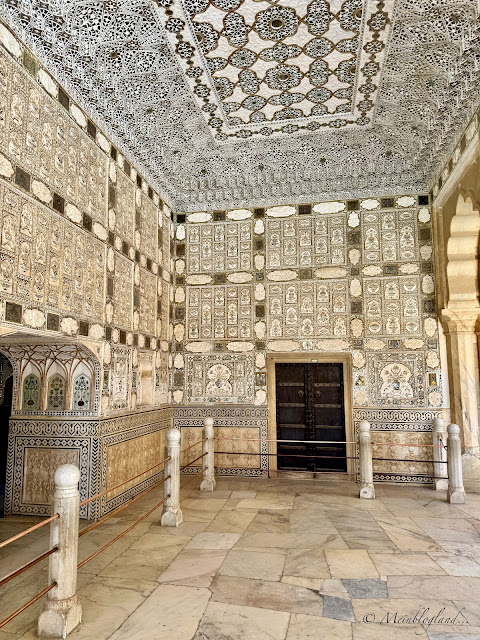














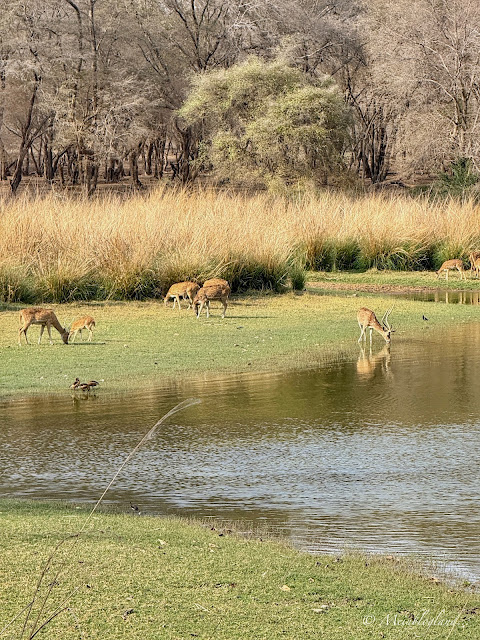






No comments:
Post a Comment
What do you think of this post? You can leave a message to let me know. Thanks!
Please note that I reserve the right to delete any comments that I deem inappropriate, offensive, spam or self-advertising. I appreciate your understanding in this matter.